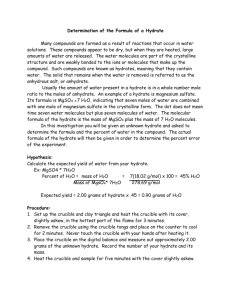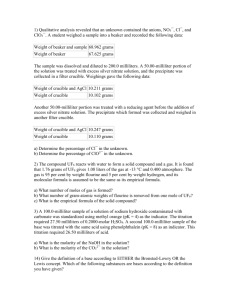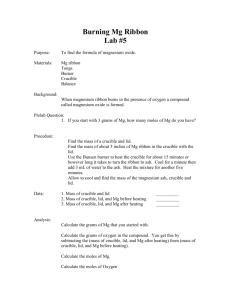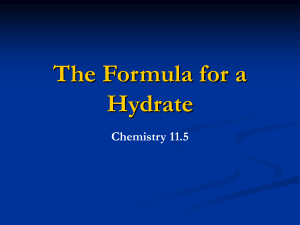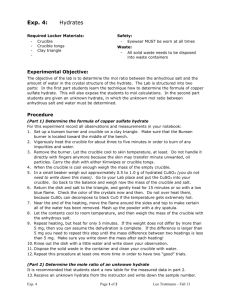Gravimetric Analysis of a Mixture Containing a Hydrate
advertisement
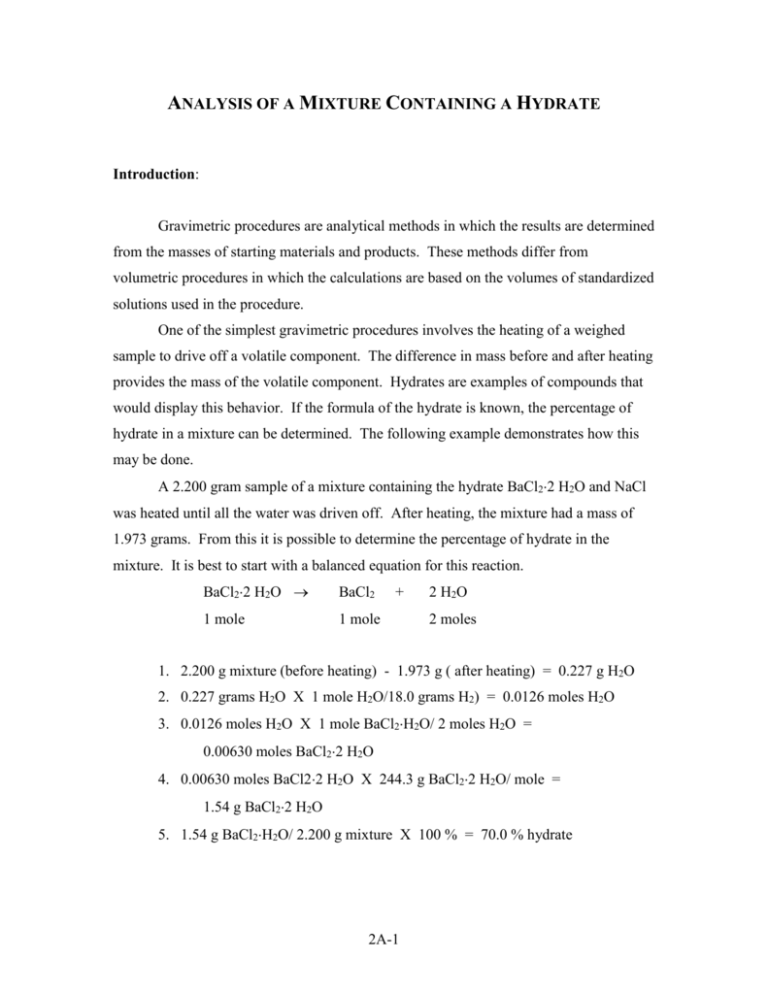
ANALYSIS OF A MIXTURE CONTAINING A HYDRATE Introduction: Gravimetric procedures are analytical methods in which the results are determined from the masses of starting materials and products. These methods differ from volumetric procedures in which the calculations are based on the volumes of standardized solutions used in the procedure. One of the simplest gravimetric procedures involves the heating of a weighed sample to drive off a volatile component. The difference in mass before and after heating provides the mass of the volatile component. Hydrates are examples of compounds that would display this behavior. If the formula of the hydrate is known, the percentage of hydrate in a mixture can be determined. The following example demonstrates how this may be done. A 2.200 gram sample of a mixture containing the hydrate BaCl22 H2O and NaCl was heated until all the water was driven off. After heating, the mixture had a mass of 1.973 grams. From this it is possible to determine the percentage of hydrate in the mixture. It is best to start with a balanced equation for this reaction. BaCl22 H2O BaCl2 1 mole 1 mole + 2 H2O 2 moles 1. 2.200 g mixture (before heating) - 1.973 g ( after heating) = 0.227 g H2O 2. 0.227 grams H2O X 1 mole H2O/18.0 grams H2) = 0.0126 moles H2O 3. 0.0126 moles H2O X 1 mole BaCl2H2O/ 2 moles H2O = 0.00630 moles BaCl22 H2O 4. 0.00630 moles BaCl22 H2O X 244.3 g BaCl22 H2O/ mole = 1.54 g BaCl22 H2O 5. 1.54 g BaCl2H2O/ 2.200 g mixture X 100 % = 70.0 % hydrate 2A-1 Many errors can be avoided in gravimetric analyses. The crucible must be clean and dry before the experiment is begun. Dry in this case means that the empty crucible is heated as hot as it will be heated during the course of the experiment. Otherwise, the moisture that adheres to most surfaces at room temperature will be lost when the unknown is heated. Once the crucible is clean and dry it should be handled only with tongs. This will prevent oil and moisture on the skin from being transferred to the surface of the crucible. Probably the most common source of error is to place the hot crucible on the lab table to speed up the cooling process. It is very easy for materials to be transferred to the crucible from the table surface and the crucible may break. All these errors can lead to errors in the calculation of the composition of the mixture. Purpose: The purpose of this experiment is to determine the amount of hydrate in a mixture containing sodium chloride and a known hydrate. Equipment/Materials: unknown mixture analytical balance crucible tongs bunsen burner clay triangle Safety: Always wear an apron and goggles in the laboratory. Remember not to touch the crucibles that have just been strongly heated. Procedure: 1. Place the clean crucible with its cover on a clay triangle and heat until the bottom of the crucible glows dull red for five minutes. Allow the crucible and 2A-2 cover to cool to room temperature. Weigh and record the mass of the crucible and cover. After the crucible and cover have been heated, they should be handled with tongs. 2. The unknown contains a mixture of a hydrate and NaCl. There is enough for two trials. Record the unknown number and the name and formula of the hydrate on your data sheet. 3. Place about two grams of the unknown mixture in the clean dry crucible from Step 1. Weigh and record the mass of the crucible and the contents in the data table. 4. Place the crucible on the clay triangle. The lid should be tilted so that the water can escape. Heat until the bottom of the crucible is red for about ten minutes. Allow the crucible to cool to room temperature. Weigh and record the mass of the crucible after heating. 5. Repeat the procedure. Calculate the percentage of hydrate in the unknown. Account for any significant deviations obtained for different samples. 2A-3 Name ______________________________ Date _______________________________ ANALYSIS OF A MIXTURE CONTAINING A HYDRATE Data Table: Unknown Number _______________ Identity of Hydrate Used _________________________ Sample 1 Sample 2 Mass of crucible, cover, and unknown Mass of crucible and cover Mass of unknown Mass before heating Mass after heating Mass of water lost % of hydrate in sample Average % of hydrate in unknown ________________ 2A-4 Calculations: Show a sample calculation in the space below. If there is any significant deviation in any of the trials, account for the differences. Questions: Would the calculated percentage of the hydrate in a sample be too high, too low, or unaffected by the following? Briefly explain why in each case. 1. The analytical balance always gives mass readings that are 0.0020 g too low. 2. The mass of the original sample is inadvertently recorded as 2.037 grams rather than 2.137 grams. 3. The mass of the completely dehydrated sample is inadvertently recorded as 1.624 grams rather than 1.642 grams. 4. The sample is incompletely dehydrated. 5. A crucible picks up “dirt” while cooling on the laboratory table. 2A-5 2A-6
